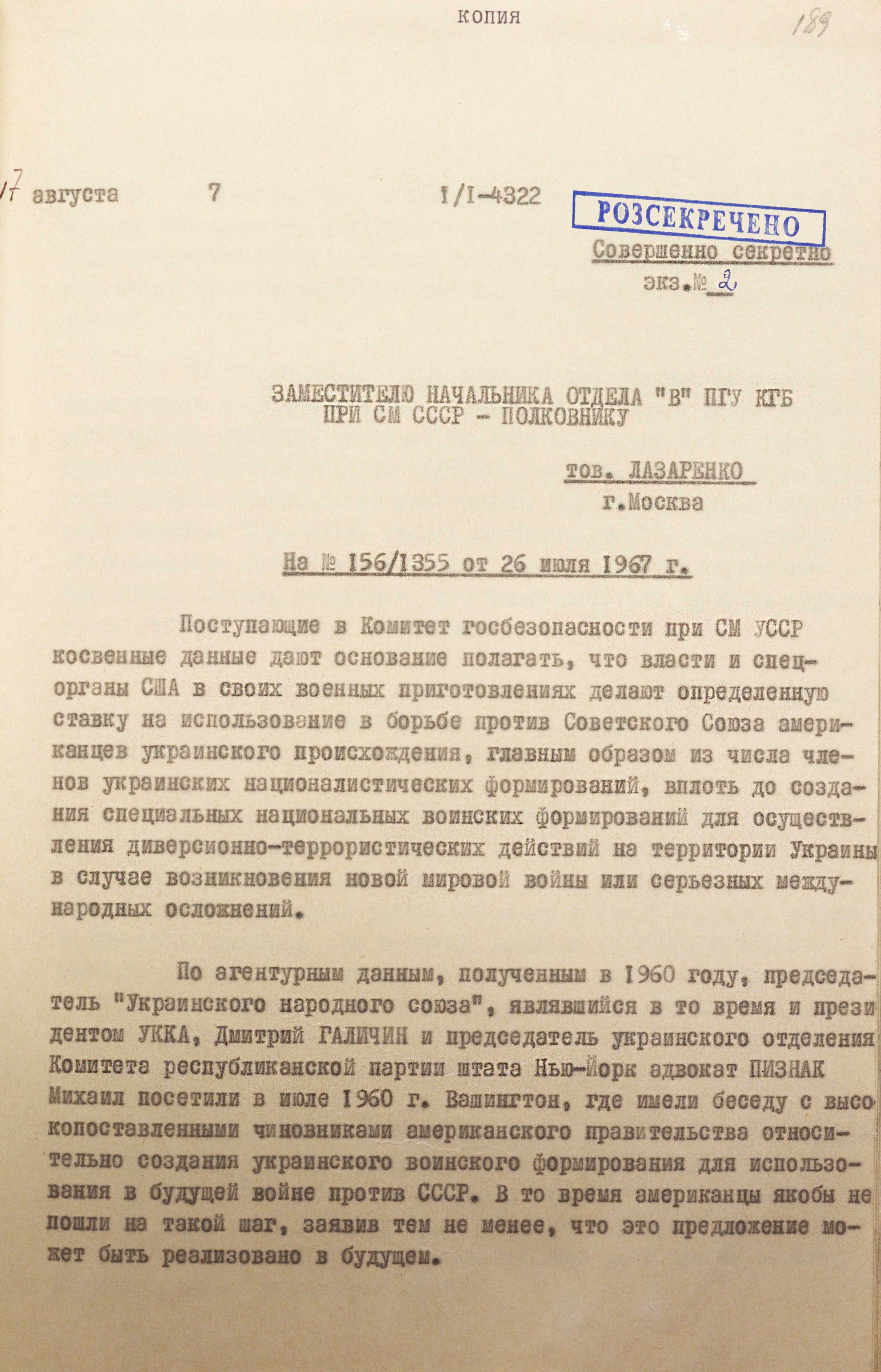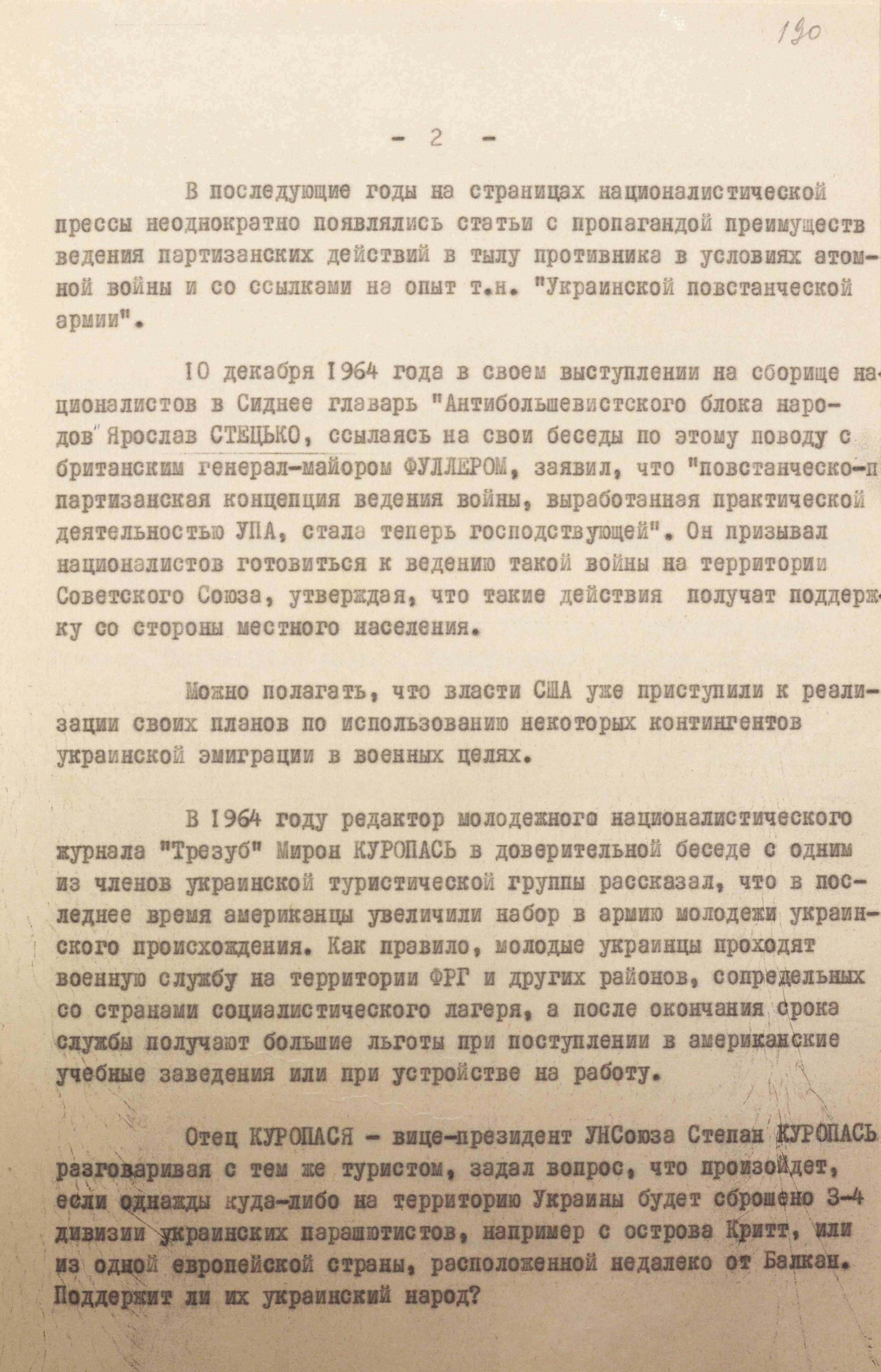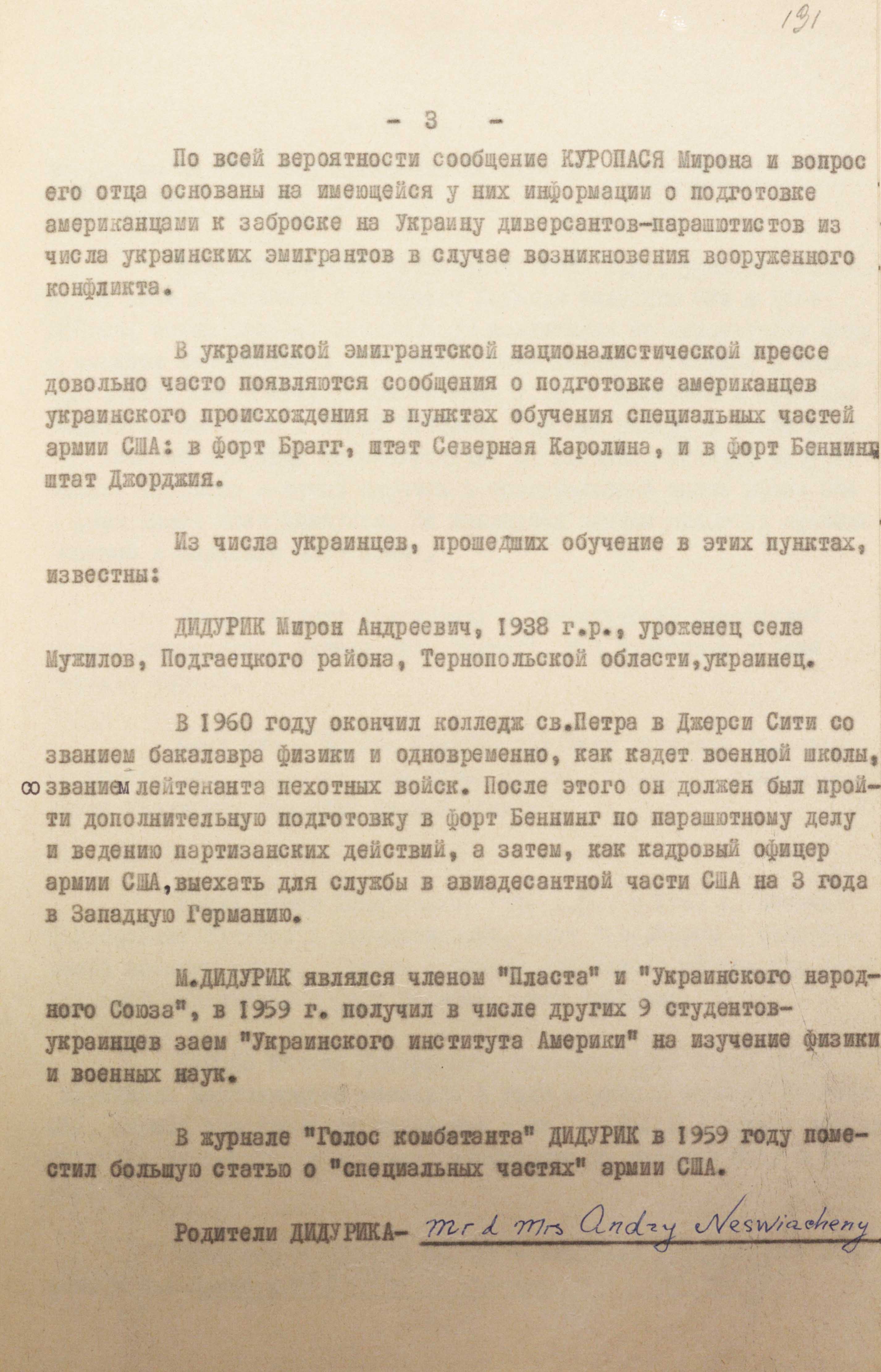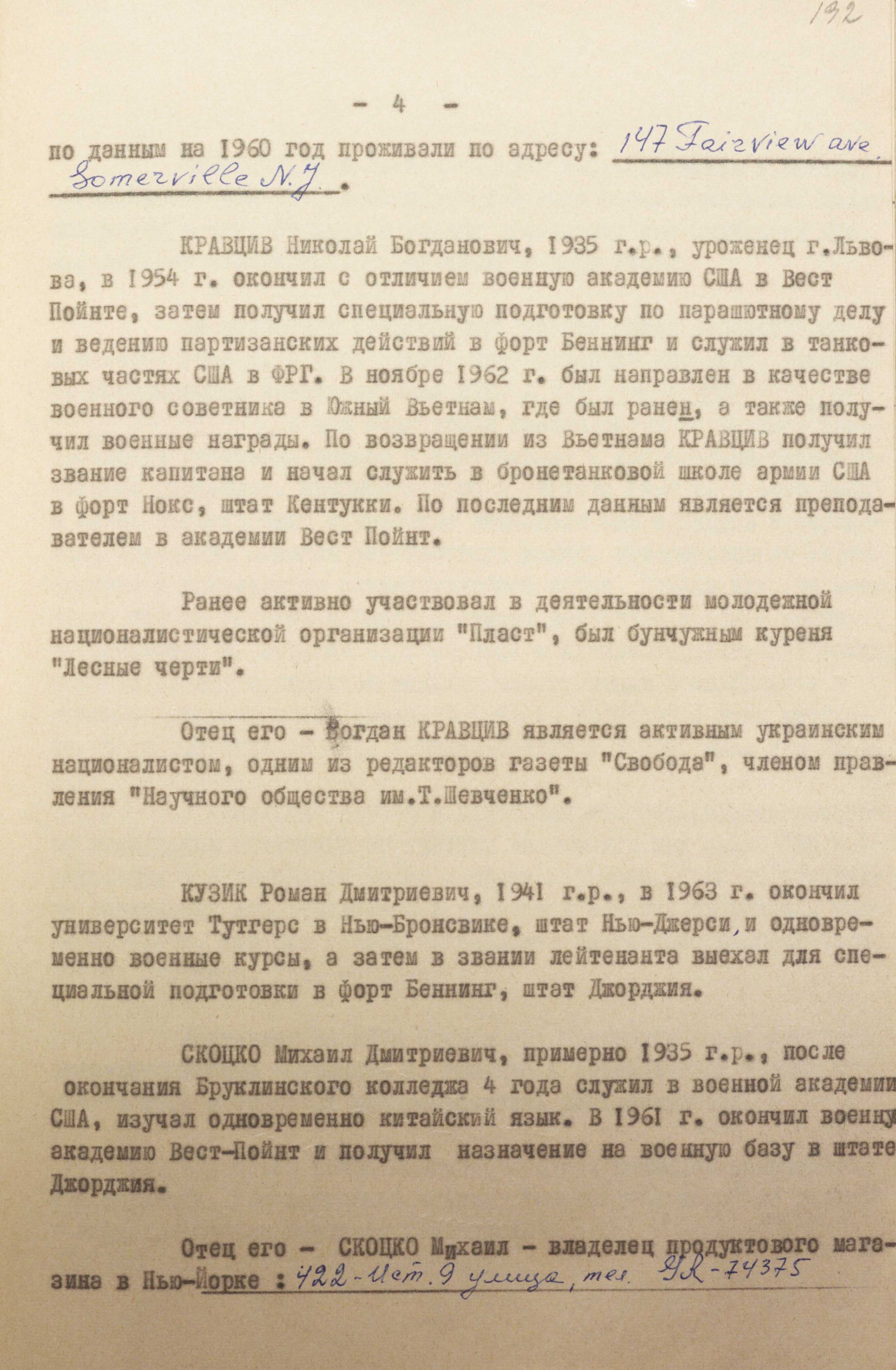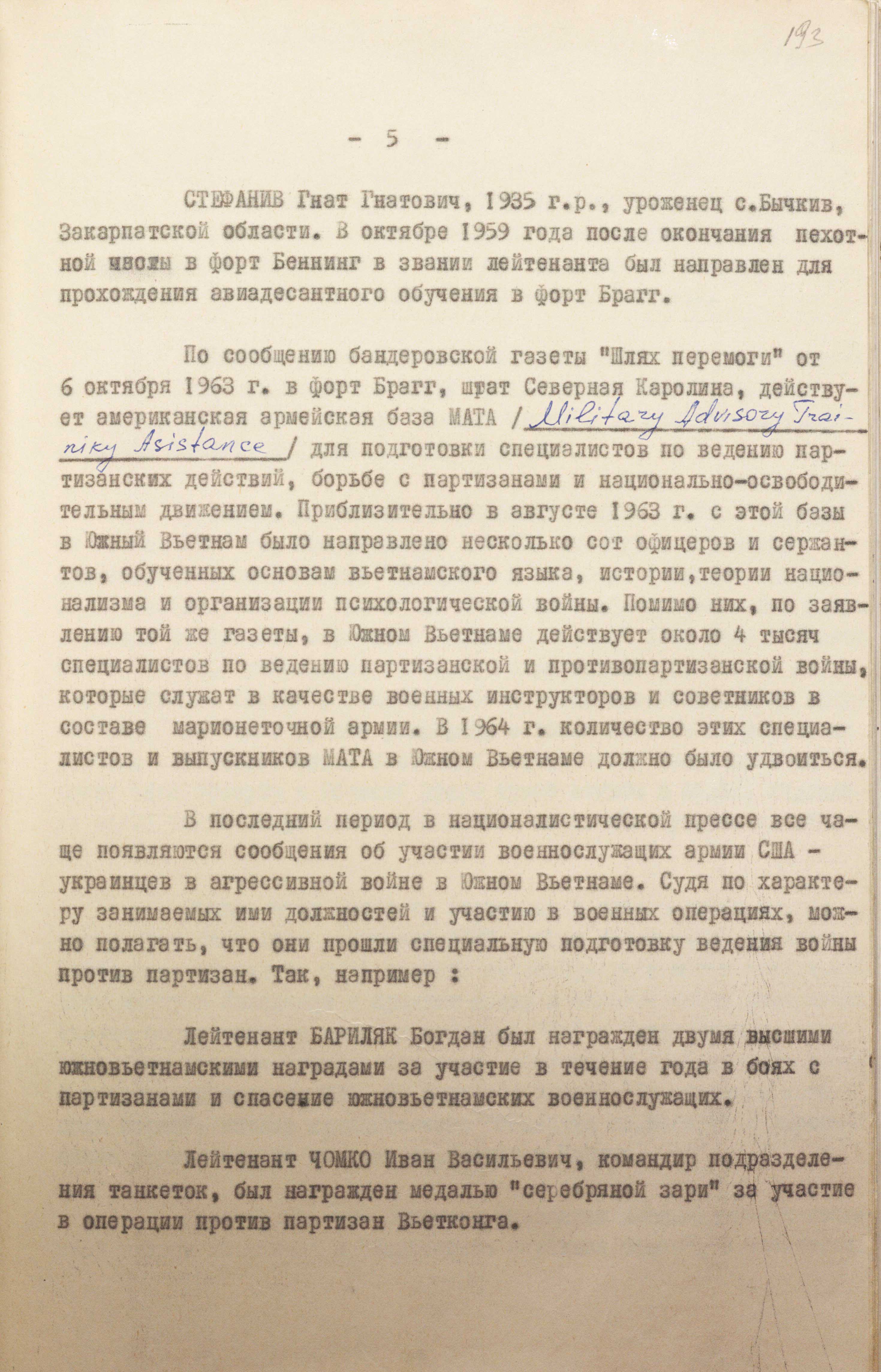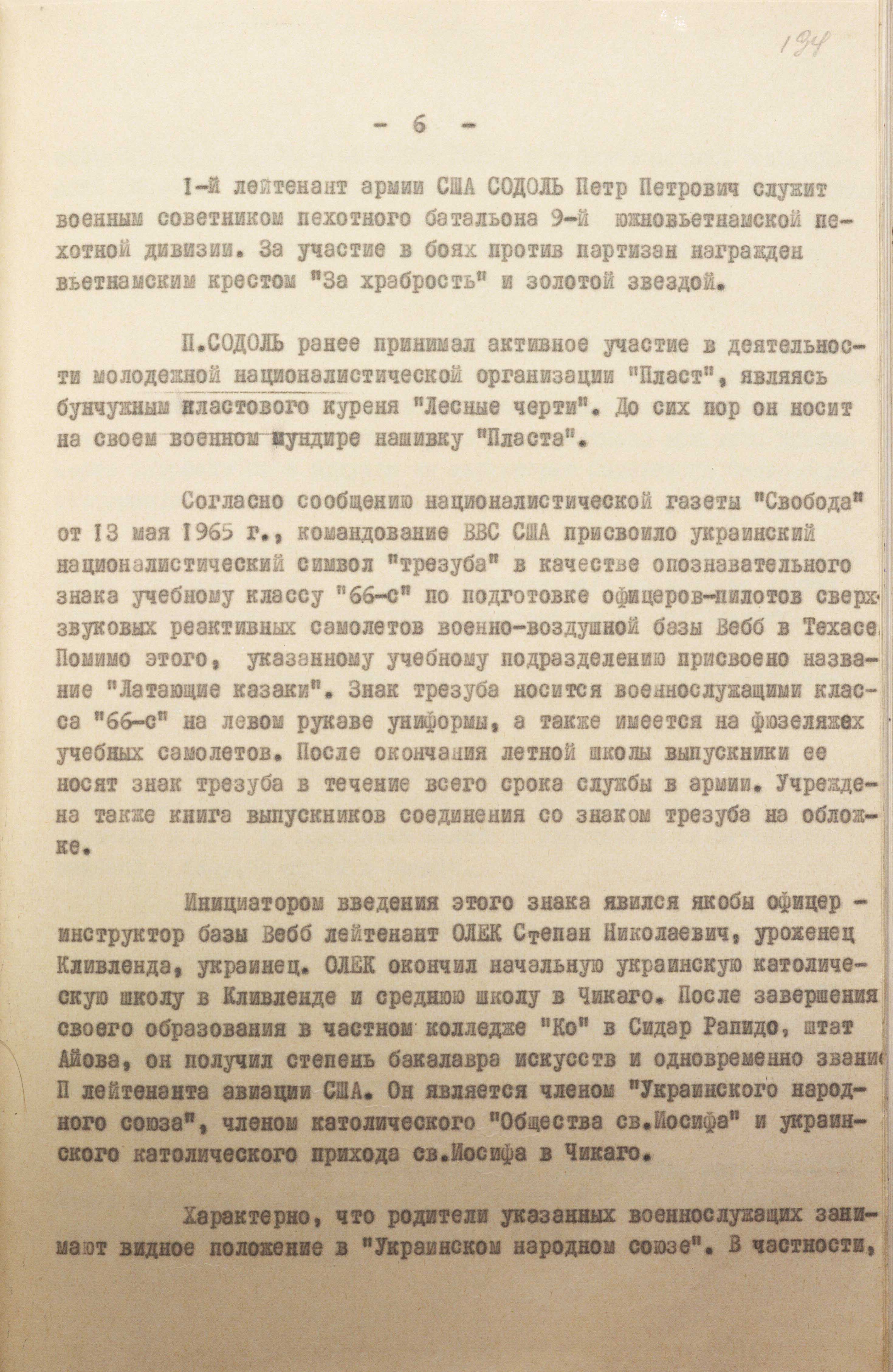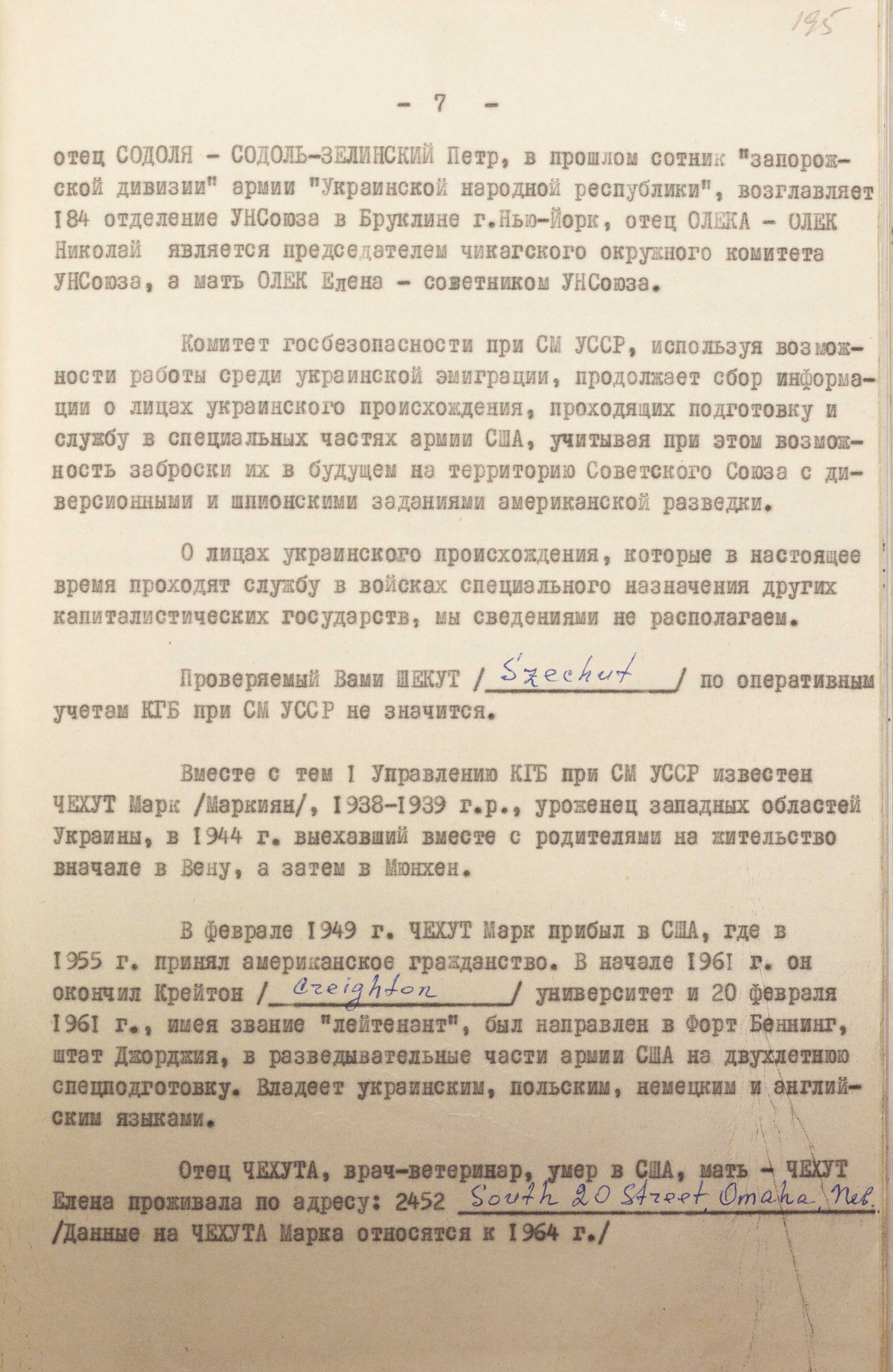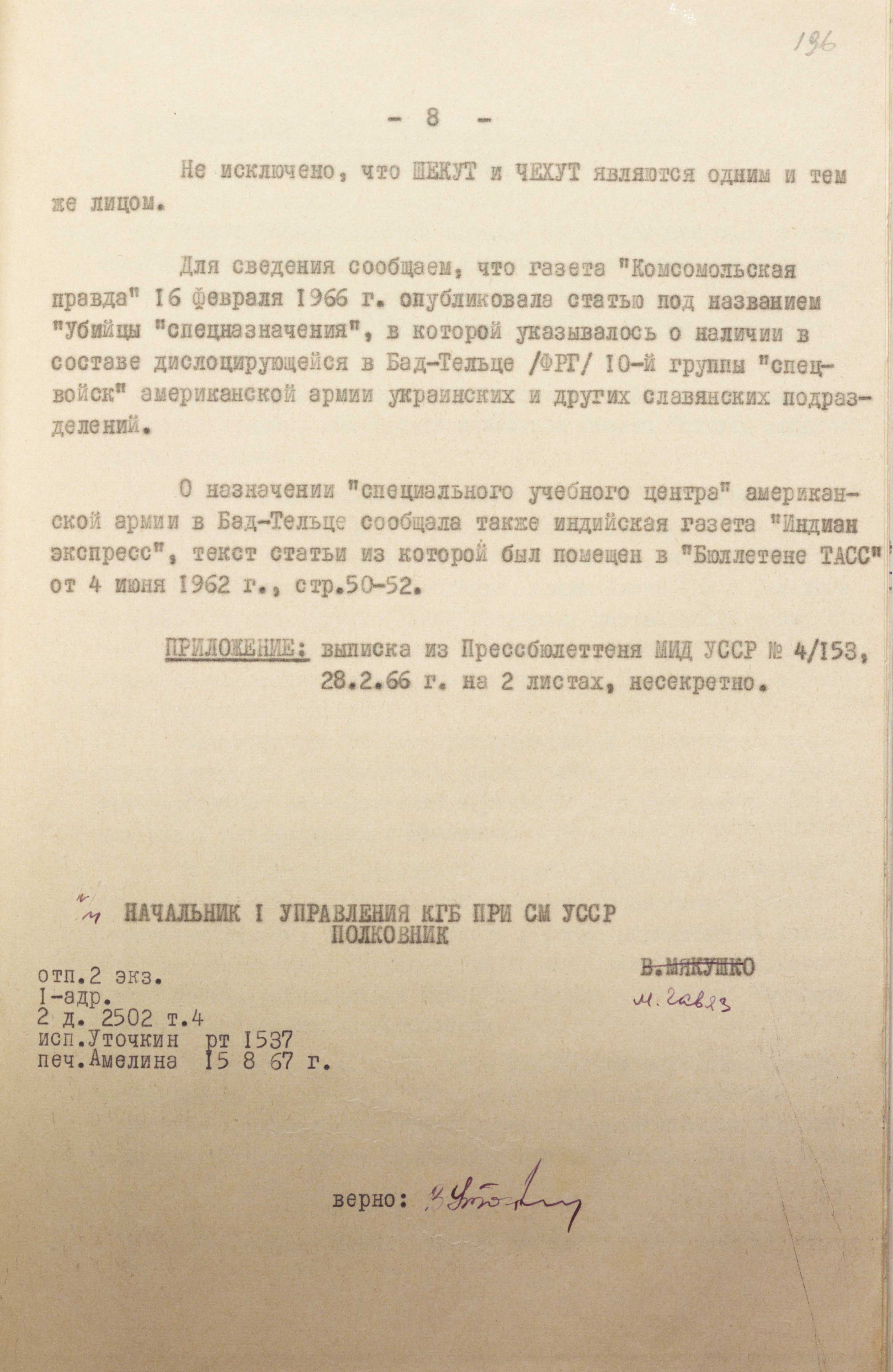kgb of the ussr Against the “Flying Cossacks” of the US Air Force
6/6/2024
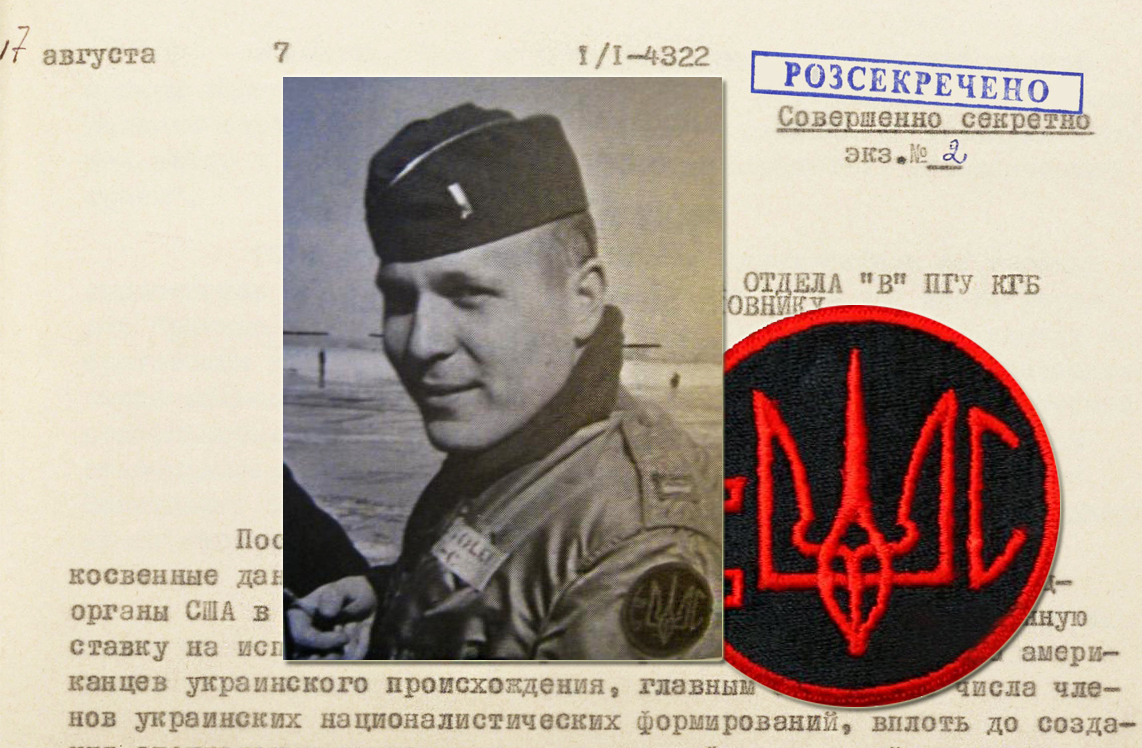
In the archival funds of the Foreign Intelligence Service of Ukraine, documents have been found which show that in the 1960s the kgb of the Ukrainian ssr purposefully collected information about US Army personnel with Ukrainian roots. Such persons were included in special lists and put on operational record. Nowadays, familiarization with these documents makes it possible to see that Ukrainian immigrants born in the United States, even in the third generation, did not lose their national identity and lived with the thought of Ukraine.
The kgb already had information that Ukrainian emigrant organizations at different times had developed strategic plans for the possible formation of national units from former military personnel. Such plans were considered mainly in the 1920s and 1930s. It was assumed that in case of a new global war between the West and the ussr, such units would be able to take part in the struggle to restore Ukraine's independence.
After the Second World War, such plans were also considered for some time. But later on, the military and political leadership of Western countries, in particular of the United States, questioned their realism. For example, one of the documents from the kgb of the Ukrainian ssr to moscow stated: “According to intelligence reports received in 1960, head of the Ukrainian People's Union, who was at that time also President of the Ukrainian Congress Committee of America, Dmytro Halychyn, and head of the Ukrainian branch of the New York State Republican Party Committee, lawyer Mykhailo Piznak, visited Washington in June 1960, where they had a conversation with high-ranking officials of the American government regarding the creation of a Ukrainian military formation for use in the future war against the ussr. At that time, the Americans allegedly did not take such a step, while stating that this proposal could be implemented in the future”(BSA of the SZR of Ukraine. - F.1. - Case 14487. - V.4. - P. 189).
Nevertheless, moscow set a task for the kgb of the Ukrainian ssr to collect all available information on this topic among Ukrainian emigrant centers abroad, in particular about all Ukrainians who joined the US Army. They were considered to be used for sabotage and espionage purposes against the ussr. Thus, the kgb leadership was wary of the information obtained by the agents about “the increase in the number of young people of Ukrainian origin recruited by the Americans”.
In another case, moscow was informed of a report by a tourist who met with Vice President of the Ukrainian People's Union Stepan Kuropas while in the United States. Kuropas allegedly asked the tourist what would happen if three or four divisions of Ukrainian paratroopers were ever landed on the territory of Ukraine and whether the Ukrainian people would support them. The kgb concluded that this was done for a reason and that such interest was based on the available information “about the Americans’ preparations to throw saboteurs-parachutists from among Ukrainian emigrants into Ukraine in case of an armed conflict”. Such artificially inflating fake threats and escalating the situation was typical of the activities of the ussr special services of that time. This was done both to further confirm their weight and importance and to mobilize the entire state apparatus and the population in the face of the “threat” from the main enemy.
So, the kgb began to purposefully compile lists of Ukrainian emigrants who served in the US Army. They included information about parents, place of residence, participation in Ukrainian organizations, address of the place of service, branch of service, and promotion. Along with such brief information, it was noted that the person was put on record in the kgb.
Here are some notes on those who were included in such lists in the 1960s:
Diduryk Myron Andriyovych, born in 1938, a native of the village of Muzhyliv, Pidhaitsi district, Ternopil region. In 1960, he graduated from St. Peter's College in Jersey City with a bachelor's degree in physics and, as a cadet at a military school, with the rank of lieutenant in the infantry. After that, he had to... go to West Germany to serve in the US Airborne Forces for 3 years. M. Diduryk is a member of Plast and the Ukrainian People's Union...
Kravtsiv Mykola Bohdanovych, born in 1935, a native of Lviv, graduated with honors from the US Military Academy at West Point in 1954, after which he was specially trained in parachuting and guerrilla warfare at Fort Benning and served in US tank units in Germany... According to recent reports, he is a lecturer at West Point Academy. Previously, he took an active part in the activities of the youth nationalist organization Plast, and was a Bunchuzhnyi ( First Sergeant- Transl.) of the Forest Devils Kurin. His father, Bohdan Kravtsiv, is an active Ukrainian nationalist, one of the editors of the “Svoboda” newspaper, and a member of the board of the Taras Shevchenko Scientific Society.
Kuzyk Roman Dmytrovych, born in 1941, graduated from the University of New Brunswick, New Jersey, in 1963, and at the same time took military courses, and then went to Fort Benning, Georgia, for special training as a Lieutenant.
Skotsko Mykhailo Dmytrovych, born in 1935, having graduated from Brooklyn College, served for 4 years at the US Military Academy, while studying Chinese. In 1961, he graduated from West Point Military Academy and was assigned to a military base in Georgia...
(BSA of the SZR of Ukraine. - F.1. - Case 14487. - V.4. - P.191-192).
Among others, the most detailed information is provided about Stepan Mykolaiovych Olek. It is noted that his parents were born in America and held a significant position in the Ukrainian People's Union. His father Mykola was the leader of the Chicago District Committee of the Organization, and his mother Olena was an Advisor. His son Stepan was also a member of the UNSoiuz, a member of the Catholic St. Joseph Society and St. Joseph Ukrainian Parish in Chicago. He was born in Cleveland, where he attended Catholic primary school and then high school in Chicago. Having graduated from a private college in Cedar Rapids, Iowa, with a Bachelor of Arts degree, he was commissioned a Second Lieutenant in the United States Air Force.
Apart from this, the kgb document emphasizes that Stepan Olek, while serving in 1965 at Webb Air Force Base, Texas, was proud of his Ukrainian roots and even took the initiative to name his training unit “The Flying Cossacks” and to use a red trident on a black background as an insignia.
“The US Air Force Command”, the document says, “has assigned the Ukrainian nationalist symbol of the “trident” as an insignia to the “66-c” training class for supersonic jet pilots at Webb Air Force Base in Texas. Besides, this training unit was given the name “Flying Cossacks”. The trident symbol is worn by the 66-s class on the left sleeve of their uniforms and is also on the fuselages of their training aircrafts. After graduating from the flight school, its graduates wear the trident sign throughout their service in the Army. There is also a book of graduates with the trident sign on the cover” (BSA of the SZR of Ukraine. - F.1. - Case. 14487. - V.4. - P. 194).
The newspapers of the Ukrainian diaspora published in the United States and subscribed to by the kgb through the Society for Cultural Relations with Ukrainians Abroad contain more information about Stepan (Stefan, Steve) Olek. It is pointed out that in order to approve the insignia, it was necessary to provide the Air Base Command with a story about it, a kind of historical reference. In Stepan's family, there has always been an image of the trident, it was perceived as a national symbol. To get more information, he allegedly turned to his friend, a collector of insignia and heraldry, Orest Horodytskyi from Chicago. Orest helped him prepare a reference. It stated that the trident “is the coat of arms of the mythical god of the seas, Neptune-Poseidon, that this ancient coat of arms was adopted by the Ukrainian prince Volodymyr the Great, who converted to Christianity from Byzantium and Christianized Ukraine and later defended not only his country but also Europe with its Christian culture from barbarian attacks under this coat of arms”.
The Air Base Command and the cadets of the training class liked this symbol and adopted it as their emblem. And this was despite the fact that there were no more Ukrainians in the unit. In the memorial book of the graduates of the 66-s class, it was mentioned, among other things, that the Ukrainian trident was the emblem in countless battles, in the defense of the Western world and everything that is most precious – freedom and liberty. Therefore, the class wears it with deep respect and obligation to the bright traditions of the trident and is ready to continue to defend the values that the trident has defended.
After graduation, all graduates of the 66-s class (according to one report, there were 48 of them, according to another, 41) had the right to wear the trident emblem on their sleeves during their further service. And Captain Stepan Olek, as noted in one publication, although born in America, “introduces himself everywhere as a Ukrainian of Cossack descent”.
Over the following years and decades, as evidenced by publications from the emigrant press, the Flying Cossacks often held alumni meetings to recall those events of long ago. Stepan Olek was certainly a participant in those meetings. In the summer of 1995, he visited Ukraine, Lviv, as a volunteer English instructor, not even realizing that until recently he was on the operational records of the kgb of the Ukrainian ssr.
At the same time, in addition to S. Olek, other Americans of Ukrainian descent who served in the US Air Force were also on the kgb's “lists”. All of them were put on record in the kgb as those who, in case of a new global confrontation, could join the liberation of their ancestral land from bolshevik-russian imperialism.
